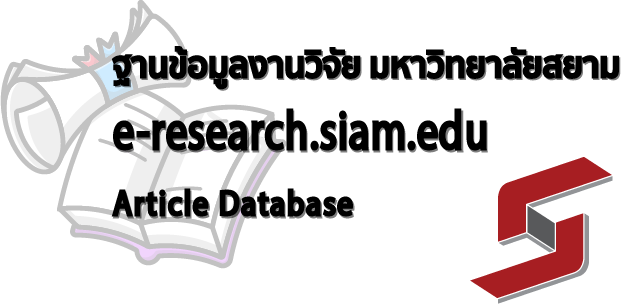- KB Home
- หลักสูตรปริญญาตรี|Bachelor Degree
- คณะวิทยาศาสตร์
- -สาขาวิชาเทคโนโลยีการอาหาร
- Compairison of Aroma Character lmpact Volatiles of thummong Leaves (Litea petiolata Hook. f.),Mangdana Water Beetle (Lethocerus indicus), and a commercial Product as Flavoring Agents in thai Traditional Cooking (SCOPUS)
| Research Article: | Comparison of Aroma Character Impact Volatiles of Thummong Leaves (Litsea petiolata Hook. f.), Mangdana Water Beetle (Lethocerus indicus), and a Commercial Product as Flavoring Agents in Thai Traditional Cooking |
| ผู้เขียน|Author: | Kanjana Mahattanatawee, Torsak Luanphaisarnnont & Russell Rouseff |
| Email: | kanjana@siam.edu |
| Department|Faculty: | Department of Food Technology, Faculty of Science, Siam University, Bangkok 10160 |
| Published|แหล่งเผยแพร่: | Journal of Agricultural and Food Chemistry, 66(10), pp. 2480–2484 |
Citation
Mahattanatawee, K., Luanphaisarnnont, T., & Rouseff, R. (2017). Comparison of aroma character impact volatiles of Thummong leaves (Litsea petiolata Hook. f.), Mangdana water beetle (Lethocerus indicus), and a commercial product as flavoring agents in Thai traditional cooking. Journal of Agricultural and Food Chemistry, 66(10), 2480–2484.
ABSTRACT
Thummong (Litsea petiolata Hook. f.) is a tree native to southern Thailand. The leaves of this tree are highly aromatic and used to flavor Thai dishes in place of the traditional water beetle Mangdana (Lethocerus indicus) for religious and cultural reasons. Total and aroma-active volatiles from both flavoring materials were compared using gas chromatography–olfactory (GC–O) and gas chromatography–mass spectrometry (GC–MS). The volatiles from Thummong leaves and the Mangdana water beetle were collected and concentrated using headspace solid-phase microextraction. A total of 23 and 25 aroma-active volatiles were identified in Thummong leaves and Mangdana, respectively. The major aroma-active volatiles in Thummong leaves consisted of 7 aldehydes, 5 ketones, and 3 esters. In contrast, the aroma-active volatiles in the water beetle consisted of 11 aldehydes, 3 esters, and 2 ketones. Both had (E)-2-nonenal as the most intense aroma-active volatile. The water beetle character impact volatile (E)-2-hexenyl acetate was absent in the leaves, but its aroma character was mimicked by 11-dodecen-2-one in the leaves, which was absent in the beetle. In addition, a commercial Mangdana flavoring was examined using GC–O and GC–MS and found to contain only a single aroma-active volatile, hexyl acetate. All three flavoring sources exhibited similar aroma characteristics but were produced from profoundly different aroma-active volatiles.
Keywords: Thai food flavoring, plant volatiles, insect volatiles.
Comparison of Aroma Character Impact Volatiles of Thummong Leaves (Litsea petiolata Hook. f.), Mangdana Water Beetle (Lethocerus indicus), and a Commercial Product as Flavoring Agents in Thai Traditional Cooking
Faculty of Science, Siam University, Bangkok, Thailand


